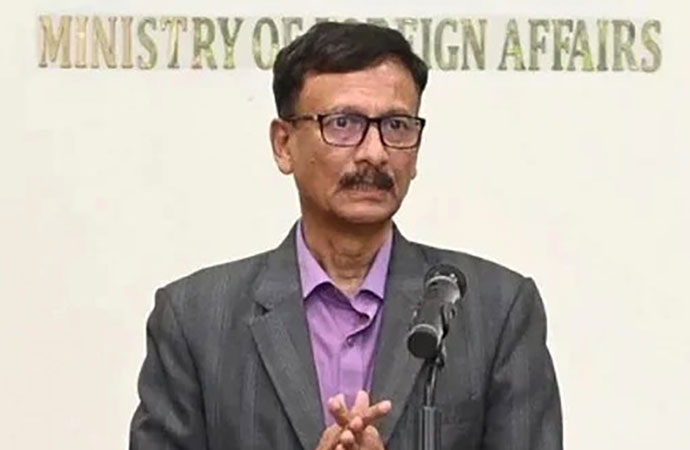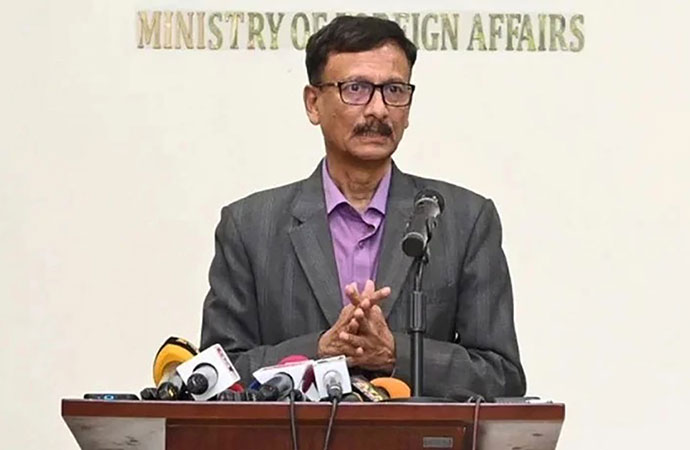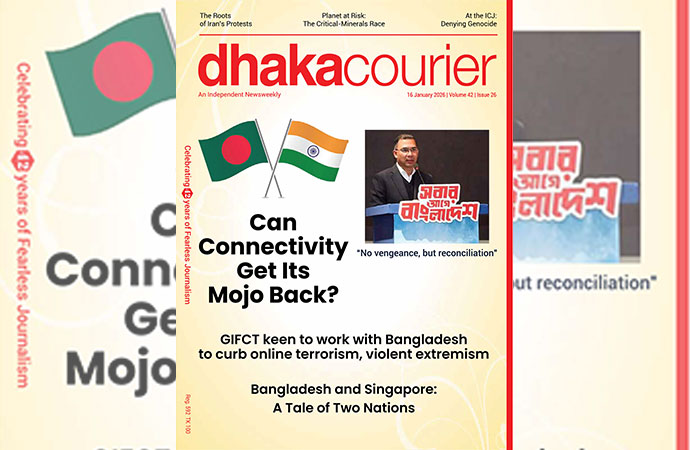Reportage

Sri Lankan security forces secure the area around St. Anthony’s Shrine after an explosion hit St Anthony’s Church in Kochchikade on April 21, 2019 in Colombo, (Photo by Stringer/Getty Images)
The people of the idyllic Indian Ocean island of Sri Lanka are no strangers to violence or even terrorism, as is well-known. By the time the Liberation Tigers of Tamil Eelam, the LTTE, which fought the state in a scathing insurgency, was finally put down through a brutal crackdown in 2009, bringing an end to a 26-year civil war, Sri Lankans had seen it all. Militant attacks against state institutions, political assassinations, suicide bombings, the works.
Next month marks the decade since the end of that conflict, although the chapter was never going to be one so easily closed. The demands for an inquiry into the end of the war, as the Sri Lankan military swept into the last sliver of land, a tiny beach, to which the last remnants of the LTTE had retreated, for possible war crimes have never gone away.
The ten years since have throughout been a time for coming to terms with the inevitable scars of that ethnic conflict fought between the majority Sinhalese and the minority Tamils, a time for reconciling. You can rest assured they were at it still on April 21, Easter Sunday, when the world turned upside-down for so many of them once again, with a force and impact even the battle-hardened among them would rarely have felt before. Certainly not in the last 10 years. As the clock hand moved past eight-thirty, several near-simultaneous blasts tore through three churches and three luxury hotels in and around Colombo, and in the eastern coastal city of Batticaloa. It was untold carnage on a scale that was surely unforeseeable. As it turned out, the security services had received a tip-off (from two foreign intelligence services) ten days prior to the attack, but a political quagmire the nation has been stuck in since last year saw to it that it wasn't dealt with (more on that later).
At the time of writing, 321 deaths have been confirmed, already making it the deadliest terror attack anywhere in the world since 9/11. Unicef said 45 of the dead were children, including the lone Bangladeshi, Zayan Chowdhury, grandson of the ruling Awami League's presidium member Sheikh Selim, a cousin of the prime minister. The victims came from at least 12 countries, but the vast majority of them were Sri Lankans. The execution, scale and coordination all bore the hallmarks of an international group such as ISIS.
Suspicion quickly centred on a little-known offshoot of the global jihadist that had established a base in the island, calling itself the National Thowheed Jamath (NTJ). The US said they were ISIS-inspired. Dozens of their operatives were arrested, although there was still no official word from the investigation. It would take well over 48 hours for the notorious mothership of terrorism, themselves embattled in recent months and rendered homeless in the Middle East, to emerge and endorse this latest act of cruelty in their image, through a simple message on its newsagency, Al-Amaq: "The perpetrators of the attack that targeted nationals of the countries of the coalitions and Christians in Sri Lanka before yesterday are fighters from the Islamic State."
The claim was lapped up by all quarters, if only because the uncertainty was becoming unbearable. Still the claim should be treated cautiously. It came as the military took on emergency war-time powers, allowing them to conduct warrantless searches and detain suspects for up to two weeks before a court hearing. If we are to take it at face value, the point that becomes immediately clear is that despite the US president's exhortations to the contrary in recent months, ISIS was far from defeated. Depriving it of territory in Syria and Iraq hardly affects its capacity to defile humanity. Of course, almost everyone except the president's most ardent followers this. This latest manifestation of their fatal world view only served to drive home the immutable nature of terrorism.
Roots of terror
Until a Sri Lankan government spokesman mentioned its name a day after the attack, very few people had heard of the NTJ even in Sri Lanka. The group is believed to have splintered off from another hardline Islamist group in the country, the Sri Lanka Thowheed Jamath (SLTJ).
While still relatively unknown, the SLTJ is a bit more established. Its secretary, Abdul Razik, was arrested in 2016 for inciting hatred against Buddhists. He later issued an apology.
Some reports have also linked the NTJ to a spate of vandalism last December that targeted Buddhist temples in Mawanella, central Sri Lanka. The faces of Buddha statues that were on display outside the temples were attacked. But the NTJ is an extremist fringe group within an already small religious minority - only 9.7% of Sri Lanka's population of about 21 million are Muslim.
Its social media presence is sparse, too. Although it has a Facebook page, it is only updated every few weeks or so. The NTJ Twitter feed hasn't updated since March 2018. The group's website is also offline - although it's not clear if it was taken down before or after the attacks. Government spokesman Rajitha Senaratne told reporters in Colombo that there had been "several warnings from foreign intelligence agencies about the impending attacks".
This isn't the only claim that officials had been alerted. Sri Lankan Telecommunications Minister Harin Fernando tweeted a document that was reportedly sent by Sri Lanka's police chief earlier this month. That document explicitly names the NTJ - as well as a warning that the group was planning to attack churches and the Indian High Commission. The document also names Mohamed Zahran, the group's leader.
The NTJ's leader, alternately known as Mohammed Zahran or Zahran Hashmi, became known to Muslim leaders three years ago for his incendiary speeches online.
"It was basically a hate campaign against all non-Muslims," said Hilmy Ahamed, the Muslim Council of Sri Lanka's vice president. "Basically, he was saying non-Muslims have to be eliminated."
Zahran's name was on one intelligence warning shared among Sri Lankan security forces, who apparently even quietly took their growing concerns to international experts as well.
Anne Speckhard, the director of the International Center for the Study of Violent Extremism, said a Sri Lankan intelligence official approached her at a conference in February with a surprising question. She was worried about what she described as a violent, homegrown jihadi group that "would just disappear" when the government tried to crack down on them.
"The intel person kind of came up to me and said, 'You know, we're kind of worried about this new group and there's some activity going. What do you think?'" Speckhard told The Associated Press. "It just kind of blows my mind that's who it was."
As far as the planning, Speckhard noted that Sri Lanka was "a part of the world that developed suicide vests" during the civil war against the Tamil Tigers, the secular, nationalist group that once was the world's top suicide attacker. But the style of Sunday's attacks, targeting churches on Easter and hotels frequented by foreigners, followed that of al-Qaida and the Islamic State group.
"It is a simple attack that is well thought out," Speckhard said. "I do believe well thought out is a product of being in touch with someone from the outside."
That's a feeling shared by the Austin, Texas-based private intelligence firm Stratfor.
"The degree of sophistication in the making of the bombs indicates that the attackers did in fact have help from outside Sri Lanka, which could have come via coordination with external militant groups such as al-Qaida or the Islamic State, from Sri Lankan fighters returning from battlefields in Iraq and Syria, or from a combination of the two," a Stratfor analysis said. "Clarity on the nature of such networks, however, will have to wait for the emergence of more details about the attacks."
Fatal distraction
As the dust settles, the rift between the country's president and prime minister, which caused a catastrophic breakdown in communications over the the intel circulating about a possible attack, will surely come under renewed scrutiny. Security agencies had been watching the National Thowheed Jamath jihadist group, reports said, and had notified police about a possible attack. But the prime minister, Ranil Wickremesinghe, and the cabinet were not informed, ministers said.
The prime minister was not privy to security briefings following a rift last year with President Maithripala Sirisena, cabinet spokesman Rajitha Senaratne told a press conference. Sirisena sacked Wickremesinghe and his cabinet in October and tried to install another prime minister, prompting a full-blown constitutional crisis. He was forced to reinstate Wickremesinghe under pressure from the nation's supreme court, but apparently kept the prime minister from security briefings.
Senaratne, the cabinet spokesman, said intelligence agencies had begun issuing warnings about the group on 4 April, after which the defence ministry sent a detailed warning to the chief of police; and on 11 April a memo was sent to the heads of several security divisions.
He said information passed to police included a warning from a foreign intelligence agency about possible attacks by the group, as well as names of members. US media reported Sri Lankan officials as saying both Indian and US intelligence had warned the country about a threat in early April.
"Our understanding is that it was correctly circulated among security and police," Shiral Lakthilaka, a senior adviser to Sirisena, told the BBC. He said that the president had appointed a special committee led by a supreme court judge to investigate what had happened.
Rauff Hakeem, the minister for town planning, called the attacks a "colossal failure of intelligence".
"It is shameful for all of us. We are all ashamed of this," he said.
Telecommunications Minister Harin Fernando tweeted: "Some intelligence officers were aware of this incidence. Therefore there was a delay in action. Serious action needs to be taken as to why this warning was ignored."
At last, to mourn
The vast majority of the victims were Sri Lankan, many from the island nation's Christian minority. Their names and other details of their lives were slow to trickle in and difficult to report, in part because authorities blocked most social media after the blasts. But among them was Dileep Roshan, 37, a carpenter who left behind a wife and daughter, his family told The Associated Press.
"His wife and daughter won't be able to do much now because he is gone," said his older brother, Sanjeevani Roshan. "The real question is what will happen to their future."
The archbishop of Colombo, Cardinal Malcolm Ranjith, said at least 110 people were killed at St. Sebastian's Church, located in a seaside fishing town at the center of Sri Lanka's small Catholic community.
Sneha Savindi was just 12 years old when she was blown apart during St. Sebastian's Easter Mass. Her uncle, Duminda, said her body had been so badly destroyed by shrapnel that the family was only able to identify her by a birthmark on her foot. Stroking the sealed coffin, Savindi's aunt, Lalitha, said, "I wanted to see you as a bride, but now you're in this box."
At Colombo's Shangri-La Hotel on Sunday, Nisanga Mayadunne posted a selfie on Facebook showing her and her relatives around a table, eating eggs and sausages. Moments later, she and her mother, Shantha Mayadunne, were killed. Shantha was an acclaimed chef who hosted live cooking programs on Sri Lankan television. "They were the most loving family anyone could ask for," Manik Mayadunne, Nisanga's cousin, wrote on his Facebook page Monday.
In some places, the violence struck entire families. On Easter Sunday, as they did every Sunday, Berlington Joseph Gomez, 33, and his wife, Chandrika Arumugam, 31, went to church at Colombo's St. Anthony's Shrine. And as always, they brought their three sons: 9-year-old Bevon, 6-year-old Clavon and baby Avon, just 11 months old.
Two days later, they were all being mourned by dozens of neighbors gathered at the modest home of Berlington's father, Joseph Gomez. Candles burned beside three coffins and women sang hymns. The bodies of two grandsons have yet to be recovered.
"All family, all generation, is lost," Gomez said.
________
The first reports of explosions came at about 08:45 local time on Easter Sunday with six blasts reported within a small space of time. Three churches in Negombo, Batticaloa and Colombo's Kochchikade district were targeted during Easter services. Blasts also rocked the Shangri-La, Kingsbury and Cinnamon Grand hotels, within walking distance of each other, in the country's capital. Police did not release a breakdown of how many people were killed and wounded at each location.
All the attacks were carried out by suicide bombers, officials said. Police then carried out raids on two addresses and there were explosions at both. One was in Dehiwala, southern Colombo, and the other was near the Colombo district of Dematagoda, where three officers were killed when a suicide bomber detonated a device.
An improvised explosive device - a 6ft-long [1.8m] plastic pipe packed with explosives - was also found and defused near the airport in Colombo.
Additional reporting by AP/UNB

























Leave a Comment
Recent Posts
Remembering Kalidas Karmakar ( ...
The art world remembers Kalidas Karmakar, a visionary whose creativity ...
An Evening with Shishir Bhatta ...
Cosmos Art Echo, the artist talk initiative of Gallery Cosmos and Cosm ...
Myanmar denies genocide, calls Rohingya crackdown co ..
Yes, of course
Earth’s average temperature last year hovered among ..
Bangladesh and Singapore: A Tale of Two Nations